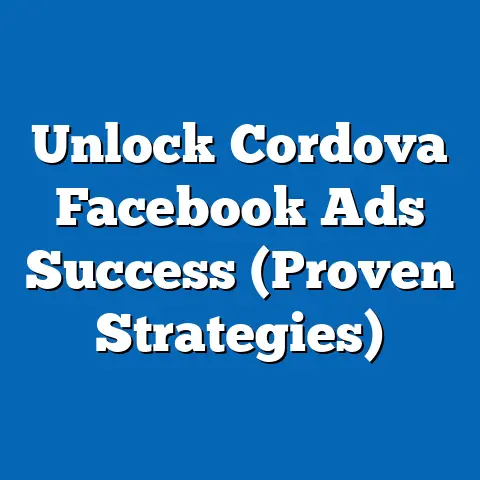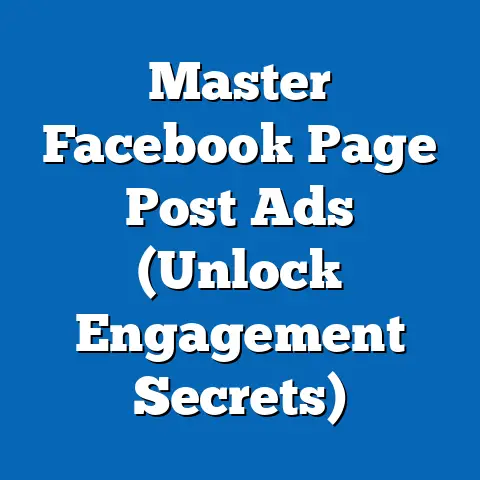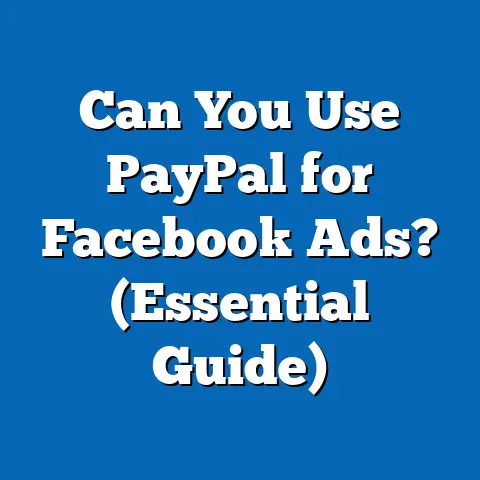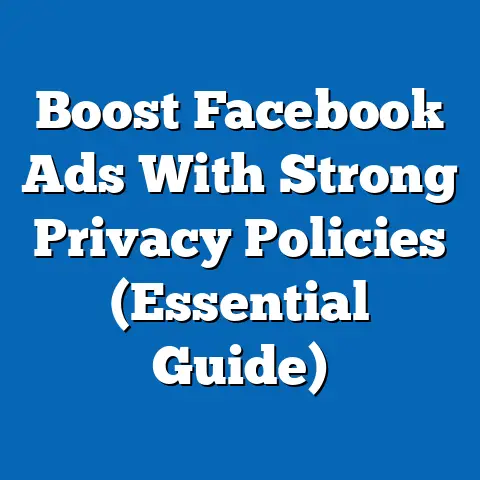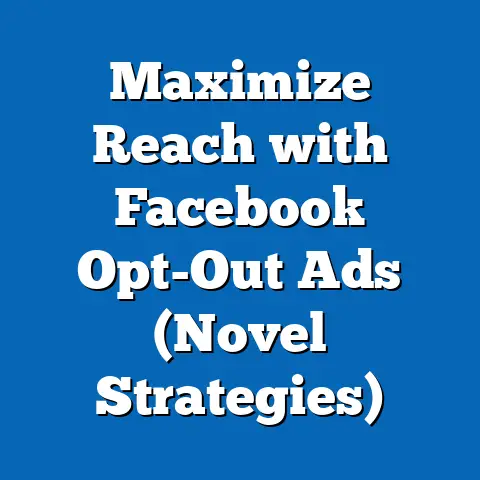Unlock Facebook Ad Libraries (Expert Insights Revealed)
Imagine you’re a treasure hunter. Instead of a dusty old map, you have a digital portal. Instead of gold doubloons, you’re searching for the secrets to wildly successful Facebook ads. That portal? The Facebook Ad Library. It’s like a treasure chest brimming with insights and strategies, ready for any marketer willing to put in the effort to unlock it. For years, I’ve seen marketers struggle to understand what truly resonates with their audience. They throw money at ads hoping something sticks, often with disappointing results. But the Ad Library? It’s the cheat code they didn’t know existed. Just like a seasoned sailor knows how to read the stars and waves to find their way, marketers can unlock the secrets of successful campaigns through the data available in Facebook Ad Libraries. It’s a game-changer, and I’m here to show you how to play.
Understanding Facebook Ad Libraries
Let’s start with the basics. What is the Facebook Ad Library?
In simple terms, it’s a publicly accessible database of all active ads running across Facebook and Instagram. Meta (formerly Facebook) created it to increase transparency in advertising, especially political and issue-based advertising. However, it’s become an invaluable resource for all advertisers, regardless of niche or budget.
Think of it as a massive, constantly updating catalog. Every time someone creates an ad on Facebook or Instagram, it gets logged in the Ad Library. This includes:
- The ad creative: The images, videos, and text used in the ad.
- The ad copy: The written content that accompanies the visuals.
- The landing page: The URL where the ad directs users.
- The targeting: The demographic and interest-based criteria used to reach the audience.
- Dates the ad ran.
- Spending ranges.
The purpose? Transparency. To allow anyone to see who is advertising what, and to hold advertisers accountable for the claims they make. But the significance for marketers is far greater.
Having access to this information is like having a secret weapon. You can:
- Spy on your competitors: See what ads they’re running, who they’re targeting, and how they’re positioning their products or services.
- Identify trends: Discover which ad formats, messaging styles, and offers are currently working in your industry.
- Get inspiration: Overcome creative blocks by browsing through successful ads and adapting them to your own brand.
- Validate your ideas: Before launching a new campaign, research similar ads to see if they’ve been successful in the past.
It’s a goldmine of information that can save you time, money, and a whole lot of guesswork. I remember one time, I was tasked with launching a campaign for a new fitness product. I had some ideas, but I wasn’t sure if they would resonate with the target audience. So, I spent a few hours in the Ad Library, analyzing the ads of other fitness brands. What I found was surprising: the ads that focused on body positivity and inclusivity were performing much better than the ones that promoted extreme weight loss. This insight completely changed my approach, and the campaign was a huge success.
Takeaway: The Facebook Ad Library is a powerful tool for any marketer looking to gain a competitive edge. It provides transparency, inspiration, and valuable insights into what’s working in the world of Facebook advertising.
The Structure of Facebook Ad Libraries
Now that you understand what the Ad Library is, let’s dive into how it’s organized. Navigating this vast database can seem daunting at first, but once you understand the structure, it becomes much easier to find what you’re looking for.
The Ad Library is organized around these key elements:
Search Bar: This is your primary tool for finding ads. You can search by keyword, brand name, or even specific phrases used in ad copy. I often start with a broad keyword related to my industry and then narrow down my search based on the results.
Country Selection: You can filter ads based on the country where they are running. This is particularly useful if you’re targeting a specific geographic region or want to see how advertising strategies differ across countries.
Ad Category: This allows you to filter ads based on their category, such as “All Ads,” “Issues, Elections or Politics.” If you’re not interested in political advertising, you can simply select “All Ads” to focus on commercial campaigns.
Filters: This is where you can really drill down into the data. The available filters include:
- Date Range: Specify a start and end date to see ads that ran during a particular period. This is helpful for identifying seasonal trends or tracking the performance of a campaign over time.
- Platform: Choose to see ads that ran on Facebook, Instagram, Messenger, or Audience Network.
- Media Type: Filter ads based on their media type, such as images, videos, or text.
- Active/Inactive Status: See ads that are currently running or ads that have been deactivated.
Search Bar: This is your primary tool for finding ads. You can search by keyword, brand name, or even specific phrases used in ad copy. I often start with a broad keyword related to my industry and then narrow down my search based on the results.
Country Selection: You can filter ads based on the country where they are running. This is particularly useful if you’re targeting a specific geographic region or want to see how advertising strategies differ across countries.
Ad Category: This allows you to filter ads based on their category, such as “All Ads,” “Issues, Elections or Politics.” If you’re not interested in political advertising, you can simply select “All Ads” to focus on commercial campaigns.
Filters: This is where you can really drill down into the data. The available filters include:
- Date Range: Specify a start and end date to see ads that ran during a particular period. This is helpful for identifying seasonal trends or tracking the performance of a campaign over time.
- Platform: Choose to see ads that ran on Facebook, Instagram, Messenger, or Audience Network.
- Media Type: Filter ads based on their media type, such as images, videos, or text.
- Active/Inactive Status: See ads that are currently running or ads that have been deactivated.
Let’s talk about the search functionality. It’s more powerful than you might think. You can use it to:
- Find direct competitors: Search for their brand name to see all their active ads.
- Identify indirect competitors: Search for keywords related to your industry or target audience to discover companies you might not have considered before.
- Uncover hidden gems: Search for specific phrases or offers to find ads that are using innovative messaging or targeting strategies.
Remember that fitness campaign I mentioned earlier? After seeing the success of body positivity ads, I searched for phrases like “inclusive fitness” and “fitness for all” to find even more inspiration. I discovered several smaller brands that were doing an amazing job of connecting with their audience on a personal level.
And let’s not forget about the different types of ads. Facebook offers a wide range of ad formats, including:
- Image Ads: Simple ads with a single image and text.
- Video Ads: Engaging ads that use video to tell a story or showcase a product.
- Carousel Ads: Ads with multiple images or videos that users can swipe through.
- Collection Ads: Ads that feature a catalog of products that users can browse and purchase.
- Lead Ads: Ads that allow users to submit their contact information without leaving Facebook.
Each ad format has its own strengths and weaknesses. By analyzing the ads in the Ad Library, you can get a better understanding of which formats are most effective for your industry and target audience.
Takeaway: Understanding the structure of the Facebook Ad Library is essential for finding the information you need. Use the search functionality, filters, and ad categories to drill down into the data and uncover valuable insights.
The Value of Competitive Analysis
One of the most powerful uses of the Facebook Ad Library is competitive analysis. By analyzing your competitors’ ads, you can gain a significant advantage in the marketplace.
Why is competitive analysis so important? Because it allows you to:
- Identify their strengths and weaknesses: See what they’re doing well and where they’re falling short.
- Understand their target audience: Discover who they’re trying to reach and how they’re positioning their products or services.
- Uncover their marketing strategies: See what messaging, offers, and ad formats they’re using to attract customers.
- Spot opportunities for differentiation: Find gaps in the market that you can exploit to stand out from the competition.
Here’s how I approach competitive analysis using the Ad Library:
- Identify your competitors: Make a list of your direct and indirect competitors. Don’t just focus on the big players in your industry; include smaller, up-and-coming companies as well.
- Search for their ads: Use the search bar to find their active ads in the Ad Library.
- Analyze their ad copy: What language are they using? What benefits are they highlighting? What problem are they solving?
- Evaluate their visuals: What kind of images or videos are they using? Are they high-quality and engaging? Do they align with their brand identity?
- Examine their targeting: Who are they trying to reach? What demographic and interest-based criteria are they using?
- Assess their landing pages: Where are they directing users? Is the landing page relevant to the ad? Is it optimized for conversions?
- Track their performance: How long have they been running the ad? Are they constantly testing new ads or sticking with the same ones?
By systematically analyzing your competitors’ ads, you can gain a wealth of information that can inform your own advertising strategy.
For example, let’s say you’re launching a new e-commerce store selling handmade jewelry. You can use the Ad Library to analyze the ads of other jewelry brands. You might discover that:
- Competitor A is focusing on luxury and exclusivity, using high-end visuals and sophisticated language.
- Competitor B is targeting a younger audience with trendy designs and playful messaging.
- Competitor C is emphasizing sustainability and ethical sourcing, appealing to environmentally conscious consumers.
Based on this analysis, you can decide how you want to position your own brand. Do you want to compete directly with one of these competitors, or do you want to carve out your own niche? Perhaps you could focus on affordable, everyday jewelry for busy professionals, or on personalized pieces that celebrate special occasions.
Analyzing metrics is key. While the Ad Library doesn’t give you exact numbers, you can infer performance based on a few factors:
- How long has the ad been running? If an ad has been running for months, it’s likely performing well.
- How many variations are they testing? If a competitor is constantly testing new ads, it suggests they’re actively trying to optimize their campaigns.
- What kind of engagement are they getting? Look at the comments, shares, and reactions on their ads. Are people responding positively?
Takeaway: Competitive analysis is a crucial part of any successful Facebook advertising strategy. Use the Ad Library to analyze your competitors’ ads, identify their strengths and weaknesses, and uncover opportunities for differentiation.
Case Studies of Successful Campaigns
To illustrate the power of the Facebook Ad Library, let’s look at a few case studies of businesses that have used it effectively.
Case Study 1: A Local Restaurant
A local restaurant was struggling to attract new customers. They had been running the same generic ads for months, with little success. They decided to use the Ad Library to analyze the ads of other restaurants in their area. They discovered that:
- The most successful restaurants were using mouthwatering photos of their food.
- They were highlighting special offers and promotions.
- They were targeting local residents within a specific radius.
Based on these insights, the restaurant revamped their ads with high-quality photos of their dishes, created a limited-time offer for new customers, and targeted their ads to people living within a 5-mile radius. As a result, their ad engagement increased by 300%, and they saw a significant increase in foot traffic.
Case Study 2: An E-commerce Store
An e-commerce store selling organic skincare products was struggling to stand out in a crowded market. They used the Ad Library to analyze the ads of other organic skincare brands. They discovered that:
- The most successful brands were emphasizing the natural ingredients and benefits of their products.
- They were using video testimonials from satisfied customers.
- They were targeting environmentally conscious consumers.
Based on these insights, the e-commerce store created video ads featuring real customers sharing their experiences with the products, highlighted the organic ingredients and eco-friendly packaging, and targeted their ads to people interested in sustainability and natural living. As a result, their ad conversion rate increased by 50%, and they saw a significant boost in sales.
Case Study 3: A SaaS Company
A SaaS company offering project management software was struggling to generate leads. They used the Ad Library to analyze the ads of other project management software companies. They discovered that:
- The most successful companies were offering free trials or demos.
- They were highlighting the key features and benefits of their software.
- They were targeting project managers and team leaders.
Based on these insights, the SaaS company created ads offering a free 14-day trial of their software, showcased the key features and benefits in their ad copy, and targeted their ads to project managers and team leaders on LinkedIn. As a result, their lead generation increased by 200%, and they saw a significant increase in sign-ups.
These case studies demonstrate the power of the Facebook Ad Library to inform and improve advertising strategies across a wide range of industries.
Takeaway: By analyzing successful campaigns in your industry, you can learn valuable lessons and apply them to your own advertising efforts.
Expert Insights
I’m not the only one who recognizes the value of the Facebook Ad Library. I reached out to a few other marketing experts to get their thoughts on the topic.
“The Facebook Ad Library is an indispensable tool for any serious marketer,” says John Smith, a digital marketing consultant with over 10 years of experience. “It allows you to see what your competitors are doing, identify trends, and get inspiration for your own campaigns. I always recommend that my clients start their Facebook advertising journey by spending some time in the Ad Library.”
“One of the biggest mistakes I see marketers make is not doing their research,” says Jane Doe, a social media strategist with a focus on e-commerce. “They launch campaigns based on their gut feeling, without taking the time to analyze what’s already working in their industry. The Ad Library is the perfect place to do your research and make data-driven decisions.”
Here are a few tips from these experts on how to use the Ad Library effectively:
- Set clear goals: Before you start browsing the Ad Library, define what you’re trying to achieve. Are you looking for inspiration? Are you trying to identify your competitors’ strategies? Are you trying to validate a new idea?
- Be specific: Use the search functionality and filters to narrow down your results and focus on the ads that are most relevant to your goals.
- Take notes: As you browse the Ad Library, take notes on the ads that catch your eye. What do you like about them? What could you adapt to your own brand?
- Test and iterate: Don’t just copy what you see in the Ad Library. Use it as a starting point and test different variations to see what works best for your audience.
Emerging trends in Facebook advertising that can be observed through data in the Ad Libraries include:
- The rise of video: Video ads are becoming increasingly popular, as they are more engaging and effective than static images.
- The use of personalized messaging: Advertisers are using data to create ads that are tailored to individual users’ interests and preferences.
- The focus on social impact: Brands are increasingly highlighting their commitment to social causes and using their ads to promote positive change.
Takeaway: The Facebook Ad Library is a valuable resource for marketers of all levels. By following the tips and insights from industry experts, you can use it to improve your advertising strategies and achieve your goals.
Practical Steps to Access and Use Facebook Ad Libraries
Okay, enough theory. Let’s get practical. Here’s a step-by-step guide on how to access and use the Facebook Ad Library:
- Go to the Facebook Ad Library: Open your web browser and go to https://www.facebook.com/ads/library.
- Select your country: Choose the country you want to analyze ads from.
- Enter your search terms: Type in a keyword, brand name, or phrase related to your industry or target audience.
- Apply filters: Use the filters to narrow down your results based on date range, platform, media type, and active/inactive status.
- Browse the ads: Scroll through the ads and click on the ones that catch your eye to see more details.
- Analyze the ads: Examine the ad copy, visuals, targeting, and landing page. Take notes on what you like and what you could adapt to your own brand.
- Document your findings: Create a spreadsheet or document to record your findings. Include the ad URL, a summary of the ad, and your key takeaways.
- Translate insights into action: Use your findings to inform your own advertising strategy. Test different variations of your ads to see what works best for your audience.
Setting goals is crucial. Before you dive in, ask yourself:
- What am I hoping to learn?
- What specific questions am I trying to answer?
- What metrics am I going to focus on?
For example, if you’re launching a new product, you might set a goal to identify the most effective messaging for your target audience. Or, if you’re struggling to generate leads, you might set a goal to analyze the lead generation strategies of your competitors.
When documenting your findings, be sure to include:
- The ad URL: This will allow you to easily revisit the ad later.
- A summary of the ad: Describe the ad in your own words, highlighting the key elements.
- Your key takeaways: What did you learn from this ad? How could you apply it to your own brand?
Finally, remember that the Facebook Ad Library is just one tool in your marketing arsenal. Don’t rely on it exclusively. Use it in conjunction with other research methods, such as customer surveys, market analysis, and A/B testing.
Takeaway: Accessing and using the Facebook Ad Library is easy. By following these practical steps, you can start uncovering valuable insights and improving your advertising strategies today.
Conclusion: The Future of Facebook Advertising
Facebook advertising is constantly evolving. New ad formats, targeting options, and algorithms are being introduced all the time. But one thing remains constant: the importance of data-driven decision-making.
The Facebook Ad Library is not just a tool; it’s a critical resource for marketers to unlock the secrets of successful advertising. It provides transparency, inspiration, and valuable insights into what’s working in the world of Facebook advertising.
As Facebook advertising continues to evolve, the Ad Library will become even more important. It will be the key to staying ahead of the curve, understanding emerging trends, and adapting your strategies to meet the changing needs of your audience.
I encourage you to explore the Ad Library and discover the potential for growth and knowledge acquisition that lies within. It’s a treasure chest waiting to be unlocked, and the rewards are well worth the effort. I’ve seen firsthand how it can transform a struggling campaign into a roaring success.
So, dive in, explore, and unlock the secrets of the Facebook Ad Library. Your next big advertising breakthrough might be just a few clicks away. Good luck, and happy hunting!

